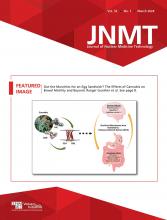RATIONALE/INTRODUCTION
The gallbladder stores and concentrates bile. Bile is a mixture of salts and lipids that break down fat and are released into the duodenum during digestion (1). Cholecystokinin, which is released by the proximal intestine in response to fat stimulation, causes gallbladder contraction and relaxation of the sphincter of Oddi.
Determination of gallbladder ejection fraction can be used to characterize gallbladder disorders, such as chronic functional gallbladder disease (2,3). The gallbladder ejection fraction can be calculated during hepatobiliary scintigraphy by inducing contraction of the gallbladder and relaxation of the sphincter of Oddi.
Historically, cholecystokinin analogs such as sincalide have been used; however, because these analogs are often subject to supply shortages, alternative cholecystagogues have been evaluated (4,5). A well-studied oral cholecystagogue is Ensure Plus (Abbott Laboratories), a liquid fatty meal (6–8). Ensure Plus is readily available, inexpensive, and effective in assessing gallbladder ejection fraction. A gallbladder ejection fraction of at least 33% is considered normal (6).
INDICATIONS
Evaluation of chronic functional gallbladder disorder.
Determination of gallbladder ejection fraction.
CONTRAINDICATIONS
Severe galactosemia, a rare hereditary disorder affecting how the body processes galactose. (This is a possible contraindication. Although patients with lactose intolerance can generally tolerate Ensure Plus, in cases of severe galactosemia, sincalide hepatobiliary scintigraphy should be considered.)
A patient not properly prepared for the procedure.
Pregnancy or breastfeeding. (Pregnancy must be excluded according to local institutional policy. If the patient is breastfeeding, appropriate radiation safety instructions should be provided.)
A recent nuclear medicine study (radiopharmaceutical-dependent).
PATIENT PREPARATION
The patient should fast for at least 2 h but preferably 4–6 h.
Ideally, the patient should have eaten within 24 h before the meal. If the test is scheduled in advance, consider having the patient ingest a fatty meal within 24 h to ensure emptying of the gallbladder before the scan.
The patient should not take opioids for at least 6 h before the examination.
A focused patient history containing the following elements should be obtained:
○ Pain location and timing relative to eating and bowel movements.
○ Previous history of gallbladder or liver disease.
○ Current medications.
○ Imaging findings, including ultrasound, CT, or MRI.
○ Lab results, including hepatic function tests and bilirubin.
○ Time and content of the last meal.
DYNAMIC AND STATIC IMAGE ACQUISITION
The radiopharmaceutical identity, dose, and route of administration are described in Table 1, and the acquisition parameters are described in Table 2.
Radiopharmaceutical Identity, Dose, and Route of Administration
Dynamic and Static Acquisition Parameters
Pre–Ensure Plus Imaging
Establish intravenous access.
Position the patient supine on the imaging table, with the γ-camera anterior to the region of the liver.
Administer the radiopharmaceutical intravenously as a bolus, begin imaging within 5 min of injection, and image for 60 min.
If the gallbladder does not fill during this period, assess the patient for pain and consider repeat imaging with the sincalide pretreatment described under “Common Options.”
After dynamic pre–Ensure Plus imaging, obtain static left anterior oblique and right lateral views to confirm gallbladder radiopharmaceutical localization.
Post–Ensure Plus Imaging
Administer 237 mL (8 oz) of Ensure Plus by mouth. Ideally, the patient should drink the total amount within 5 min.
Reposition the patient as in the Pre–Ensure Plus imaging.
Reduce liver background by positioning the γ-camera in the left anterior oblique position.
Perform dynamic imaging for 60 min.
COMMON OPTIONS
A higher administered activity (5–10 mCi) may be needed in patients with hyperbilirubinemia.
If the gallbladder is not visualized during the pre–Ensure Plus imaging, sincalide (cholecystokinin) may be administered at 0.02 μg/kg over 30–60 min.
A booster dose of radiopharmaceutical may be needed to fill the gallbladder (usually half the standard dose).
Recommend waiting 15–30 min after completion of sincalide infusion before having the patient drink the Ensure Plus and acquiring the post–Ensure Plus dynamic images.
PROCESSING INSTRUCTIONS
On the post–Ensure Plus dynamic images, place a region of interest over the region of the gallbladder (Fig. 1).
Ensure that the gallbladder remains within the ROI throughout the post–Ensure Plus dynamic imaging, manually shifting the region of interest if needed, as the position can change with patient motion or respiration.
Generate a time–activity curve (Fig. 2).
Determine the percentage gallbladder ejection fraction as [(gallbladder maximum − gallbladder minimum)/gallbladder maximum] ×100.
Creation of region of interest (ROI) encircling radiopharmaceutical-outlined gallbladder. Ensure that gallbladder remains within ROI throughout post–Ensure Plus dynamic imaging.
Time–activity curve for gallbladder ejection fraction, determined from counts within gallbladder ROI throughout course of post–Ensure Plus dynamic imaging. Bkgd = background; EF = ejection fraction; T Max = time of maximum counts/s; T Min = time of minimum counts/s.









